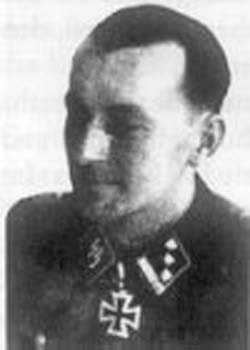Allegiance Nazi Germany Battles/wars World War II Died May 1945, Berlin, Germany Service/branch Waffen-SS | Years of service 1939–45 Name Rudolf Saalbach Battles and wars World War II | |
 | ||
Born 18 March 1911
Grossenhain, Germany ( 1911-03-18 ) Rank Sturmbannfuhrer (Major) Awards Knight's Cross of the Iron Cross
Iron Cross I Class
Iron Cross II Class
Panzer Badge
Eastern Front Medal
Close Combat Clasp in Bronze
War Merit Cross with Swords Unit SS-Totenkopfverbande, 3rd SS Panzer Division Totenkopf | ||
Rudolf Saalbach (18 March 1911 — May 1945) was a Sturmbannfuhrer (Major) in the Waffen-SS during World War II. He was awarded the Knight's Cross of the Iron Cross, which was awarded to recognize extreme battlefield bravery or successful military leadership by Nazi Germany during World War II.
Contents
Early life
Rudolf Saalbach was born on 18 March 1911 in Grossenhain, Germany. He was a member of the NSDAP (party number 1375011) and volunteered to join the SS (SS service number 127697) in 1934. He was assigned to the SS-Sonderkommando in Sachsen until 1937 when he was transferred to the SS-Totenkopfverbande stationed on the Elbe. He was then selected to become an officer and posted to the SS-Junkerschule in Braunschweig in 1938.
World War II
By August 1940, Saalbach had been promoted to Obersturmfuhrer (First Lieutenant) and was the commander of the 1st Motorcycle Company, 3rd SS Reconnaissance Battalion, SS Division Totenkopf. He was later transferred to command the 5th SS Panzer Reconnaissance Battalion, 5th SS Panzer Division Wiking in March 1943, with the rank of Hauptsturmfuhrer (Captain). Upon the formation of the 11th SS Volunteer Panzergrenadier Division Nordland in May 1943, he assumed command of the 11th SS Armoured Reconnaissance Battalion.
Saalbach was awarded the Knight's Cross for his bravery and leadership between 12 and 19 March 1944, in Hungerburg and also promoted to Sturmbannfuhrer.
Saalbach was still in command of the battalion during the Battle of Berlin and organised a breakout attempt with the last 36 men of the battalion on 2 May 1945. He was last seen on the Weidendammer Bridge on the Charlottenburg, which was the last time any of his group were seen alive.
